First ski trip from USA to the French Alps
Which ski destinations in France offer the best skiing and the most fun early season over Christmas and New Year: the Espace Killy, the Three Valleys or Chamonix Mont-Blanc? An easy decision perhaps for some European skiers, but what if you’re flying long haul for your first ski vacation in the French Alps? Will it be truly memorable and how does skiing in France compare to skiing in the USA? Jules Gansl was determined to find out for herself…
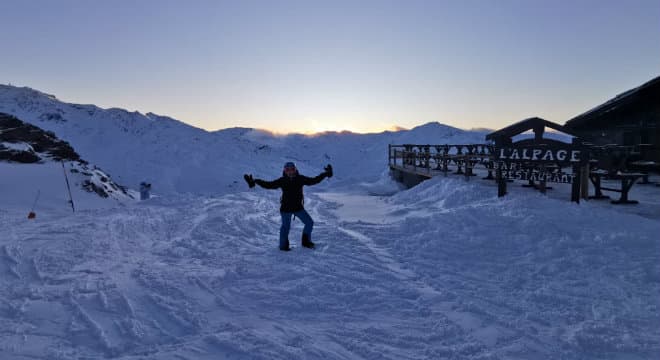
©Juliana_Gansl
Towards the end of 2019, I realized I could string together three weeks of vacation over the Christmas and New Year’s holidays. Of course, the only decent way to spend any vacation is skiing. Unfortunately, none of my friends or family could also take 3 weeks off, so it was either go alone, or don’t go at all. So, I went.
Well, first I started researching. I decided to focus on France since I had never skied there before, and it’s home to some of the biggest ski areas in the world, including the Espace Killy and the Three Valleys, each with multiple peaks over 9,000 ft and generally snow-sure. Most importantly, if it did turn out to be a low snow December, at least I’d have croissants….and wine.
I ultimately selected Val d’Isere and Val Thorens as they are the highest elevation resorts in the Espace Killy and Three Valleys, and I read that they had the liveliest towns. For my third and final week, I decided on Chamonix because of the town’s fun reputation and legendary off-piste terrain.
With my destinations lined up, I looked at rental cars and flights into both Geneva and Lyon, the closest airports. I found a direct roundtrip JFK-Amsterdam flight for only 50K Delta points, and then booked connecting flights to Lyon on KLM. A strange Delta/KLM routing issue wouldn’t let me book the award ticket all the way to Lyon, but I didn’t mind as Amsterdam is one of the easiest airports to connect through. I also chose SkyTeam flights as I planned to bring my ski boots and skis – it’s too expensive to rent for 3 weeks – and my Delta status allows me to check luggage for free.
Pro Tip: on most airlines, a boot bag and ski bag are considered one piece of checked luggage, but make sure to check their luggage policy.
I also made sure to reserve a car with winter tires and chains, as they are mandatory to drive into the mountains this time of year – and thank goodness I had them as I had to drive up very steep switchbacks to Val d’Isere in a gnarly snow storm.
Pro Tip: book reservations with at least two rental car providers – choose the pay later option of course – as your reserved car is NOT guaranteed to be available when you arrive, and automatic, 4WD cars with winter tires and chains will be in high demand.
Finally, I had to find accommodation. I wanted to be centrally located, in walking distance of bars, restaurants, shops and the resort – but I also wanted certain amenities including a modern/recently renovated space, basic kitchen and linen supplies, and complimentary wi-fi and parking. Since I was staying across both low and high demand weeks, I hoped to spend less than USD $150/night on average.
Options included hotels, hostels, chalets and AirBnBs. My preferred hotels were generally over USD $1,000 for 7 nights, although I liked that many offered complimentary breakfast. There were only a few hostel options, but I didn’t feel like sharing a room with up to six strangers (I have too much ski gear!). I spoke with a UK-based company about staying in chalets – which seemed like a great idea as breakfast and dinner is included and it would be quite a social environment – but the company couldn’t find any chalets that met both my criteria and budget. AirBnB ended up having plenty of selection, and I easily booked three perfect apartments, spending on average USD $133 per night for 21 nights.
Val d’Isere
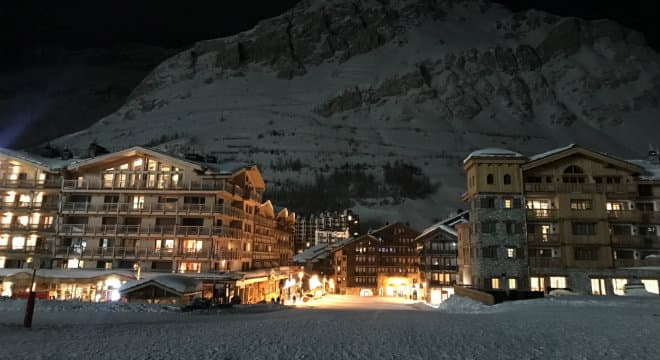
©Juliana Gansl
After landing in Lyon, I got my rental car and started the 2.5-hour drive to Val d’Isere at the eastern end of the Vanoise National Park. Several Brits I met described Val d’Isere as a “chocolate box town,” meaning it’s wonderfully picturesque. They were right.
The main street is lined with ski stores, bakeries, restaurants and bars. Some of the side streets are located next to the base area, making everything centrally located and easily accessible. Val d’Isere, combined with its neighboring resort, Tignes, make up one of the largest ski regions in France – the Espace Killy I purchased a 6-day pass with access to both resorts for USD $290 (including insurance for $2 per day, which would come in handy in case of an emergency). I also pre-booked two off-piste group guided days with The Development Centre (TDC), so that I could explore more challenging terrain and get the most out of the Espace Killy.
Pro-Tip: for skiers used to North American resorts – where mostly all trails, trees and bowls are considered in-bounds and therefore avalanche controlled, patrolled and marked – in Europe, plenty of lift-accessible terrain isn’t avalanche controlled, patrolled or marked. Make sure to familiarize yourself with Europe’s piste and off-piste definitions to avoid ending up in potentially life-threatening situations. Local piste maps are clear, but if in any doubt check your understanding on arrival.
My guides, Steve Angus and Rich Jones, were both professional, easy to communicate with, and extremely knowledgeable about the area. I happened to ski with them on two of the cloudier days, and they did an excellent job of finding untouched powder runs unaffected by the wind. Most importantly, I felt incredibly safe in their care, and would highly recommend them both.
Pro Tip: ensure you have a good low-light lens when skiing in Europe as most resorts are above the tree line, which means that visibility will always be poor when it’s cloudy.
As a solo traveler, I made a sincere effort to talk to strangers and say yes to as much as possible. My first afternoon after skiing I stopped into Chez Jules and the owner and I ended up taking shots of Génépy – an aperitif native to the region – in honor of sharing the same first name. On my second day, I started chatting with a group of young French skiers on the gondola and ended up skiing the entire day with them – including stopping for a delicious lunch at La Fruitiere and then for champagne and dessert at the infamous La Folie Douce next door. While walking around town another night, I befriended a group of lads from Manchester, UK, and met them the next several afternoons at CocoRico to dance on tables and drink caramel flavored Polish vodka.
In Val d’Isere my AirBnB apartment was in a small building located on Rue du Cachay in Rond Point des Pistes, next to the central bus round-about. It was a one-minute walk to the Solaise and Olympique lifts, 30 seconds to the CocoRico, and 5 minutes to the main street (just walk across the ski trail). The apartment luckily included a free, covered parking spot. I highly recommend staying in this area if options are available.
When my seventh day came, I was truly sad to have to leave Val d’Isere – I would have been perfectly happy spending my entire trip in The Espace Killy – but the Three Valleys was up next.
Ultimate-Ski guide to Val d’Isere >
Search accommodation in Val d’sere and book online >
Val Thorens
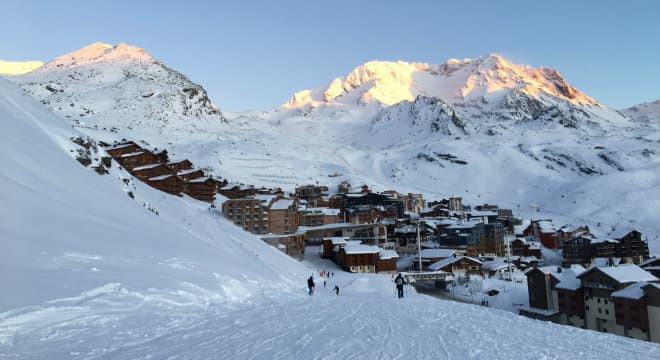
©Juliana Gansl
About a 2-hour drive from Val d’Isere, on the far western side of the Vanoise, sits Val Thorens – the highest ski resort in Europe. Val Thorens is also part of the largest interlinked ski region in the world, the Three Valleys (Les Trois Vallées), with access to multiple famous resorts including Meribel and Courchevel. Unlike Val d’Isere, which is organized around a flat, main street, Val Thorens is built on the mountain side, with apartment buildings, shops and restaurants winding up and down the slopes. Although this means you can essentially ski in/out of nearly every building, it also means that there isn’t a centralized town vibe. The closest thing to a town center is the Place de Caron, which is a long street that includes the Sports Center on one end and the tourist office on the other, with several bars and restaurants in between. If you continue walking up from the Rue Caron and head up the Rue de Gebroulaz, you’ll find more shops, restaurants, bars and hotels.
Upon arriving, I went to the ski pass office on Place de Caron and purchased a 6-day Three Valleys pass for USD $360 (including insurance). Unfortunately, I arrived right at the start of a three-day, non-stop snowstorm, which grounded nearly all the lifts, and closed all the connections to other resorts. The first day of the storm was pretty cool as I skied in absolute zero visibility in knee-deep powder unsure of where trails started, ended or dropped off. By Wednesday the storm passed, but not before warming up and leaving a two-inch breakable crust on top of light snow, which created the most challenging “powder” conditions I’ve ever skied. The snow stayed fairly challenging until Friday, when the temperature finally dropped, the clouds fully cleared, and I was able to ski into Meribel for a few hours and enjoy a little more of the huge Three Valleys ski area.
Like Val d’Isere, I contacted Le Maison des Guides et de la Montagne Val Thorens to book two group off-piste guided days. I skied with Carine the two days following the storm, who was easy to communicate with, very safety conscience, and ensured I got to see a powdery side of Val Thorens that would be otherwise inaccessible.
Some of the highlights of the week included: stumbling into the camouflaged Village Igloo Bar near the Cascades Lift during the snow storm and discovering that the interior was filled with fantastic characters sculpted into the ice walls; my daily stop into Le Coq Val Thorens on Place de Caron for a Vin Chaud (hot wine) and late lunch (omg the burger!); and the night I sat down at the bar at La Pause de Pierrette, and was immediately invited by a group of local ski instructors to a raclette and charcuterie dinner at their home.
In Val Thorens, I rented an apartment in a large building on Grand Rue, just a block south of the Sports Centre / Place due Caron and a block north of the top of the Cairn Gondola. Street parking in Val Thorens is quite limited, so I parked my car in a Valthoparc garage a block away, which only cost ~$80 USD for the week. The building was quite centrally located and essentially ski in/ski out, but if I were to return to Val Thorens, I would look at options on the north side of the Place due Caron so I wouldn’t have to walk through the cavernous Sports Centre to get to the main part of town.
Once again, my seventh morning arrived too soon, and I packed up and hit the road to drive to my third and final destination, the formidable Chamonix.
Ultimate-Ski guide to Val Thorens >
Search accommodation in Val Thorens and book online >
Chamonix Mont Blanc
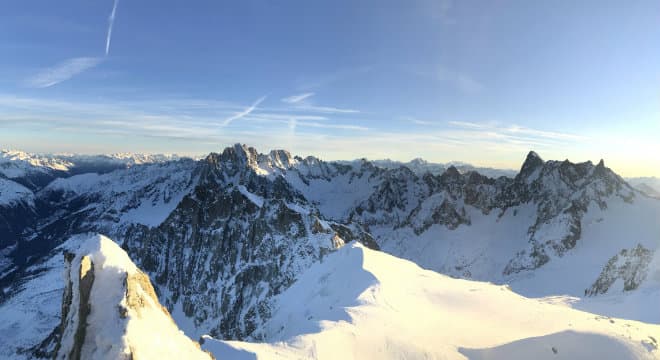
©Juliana Gansl
Almost exactly due North, about 2.5 hours from Val Thorens, awaited Chamonix – one of the premier ski destinations in the world with access to resorts in France, Switzerland and Italy. With a large, picturesque main street lined with hundreds of bars, restaurants and shops, Chamonix is more of a ski city than a ski town. I loved walking up and down the car-less Avenue Ravenel le Rouge, stopping into the Savoyard stores for tastes of saucissons or Beaufort (a local, gruyere-like cheese), or admiring all the beautiful ski outfits at Moncler, Eider and Snell Sports.
Chamonix is a very unique ski destination in that the typical ski in/out setup doesn’t exist. Rather, the town is a vibrant and central place to stay in order to access a half dozen ski resorts within an hour’s drive. Tourists and guides fill the streets, hauling their gear to various bus stops or meeting points to be driven to their chosen resort of the day. Unlike Val d’Isere or Val Thorens, the on-piste skiing around Chamonix is more limited, so I booked three off-piste days with Compagnie des Guides USD $99 per day. I used my Mountain Collective pass to get two complimentary lift passes, and then purchased single tickets for the remaining days.
Each evening, I received a call from my guide with the time and place to meet the next morning. It was a little strange not knowing where I would be skiing, but I liked the chaos of showing up at the Compagnie des Guides office at 8am, hopping into a van full of strangers, and trusting that the day would be filled with good company and good snow. The groups were a little larger than preferred (up to 8 people), but the guides did a nice job of quickly evaluating and arranging clients into similar level groups.
The first day we drove about 20-minutes north to Grand Montets above the village of Argentière. While the guide was nice and knowledgeable, and the views were gorgeous and clear, the conditions were quite hard and heavy for an off-piste day. Ignoring my sore legs, I went the next day with the same guides to Le Tours. Despite not having any new snow, the conditions were ideal – plenty of fluffy lines to poach on the backside of the mountain and lift-accessible hikes to much steeper and challenging terrain. Moreover, the front side of the mountain had some of the widest trails I had seen in France to-date, so I made a mental note to return on my last ski day to do groomer laps on slalom skis.
The penultimate off-piste experience in Chamonix is the Vallee Blanche – a multi-mile glacier starting near the top Aiguille du Midi, easily accessible from a cable car in the center of town. I learned that this early in the season the only way to ski the Vallee Blanche was with a private guide (up to two people for USD $385). So, I found a friend and paid the incremental fee to the guide company. (Plus the sticker-shock additional USD $75 to take the cable car as the Mountain Collective tickets do not include the Aiguille du Midi.)
In order to get to the start of the Vallee Blanche, you must exit the Aiguille du Midi through an icy tunnel and walk down a ridgeline with 50-degree pitches on both sides, all while carrying your skis and wearing crampons on your boots that make you walk as if you’re a little drunk. Later in the season, safety ropes are fixed along the path, but in early season skiers are roped to their guides, who use axes to anchor to the ice underneath. For this reason, safe, professional guides will only take up to two skiers in December. Pro Tip: avoid descending directly underneath idiots who are only wearing one crampon and aren’t roped to anyone or anything.
Several hours, and several hundred “Wooo-hooooos” later, the Vallee Blanche did not disappoint. It was a truly memorable, once-in-a-lifetime experience – even with a 20-minute hike up the mountain towards the end which was required due to the low snowfall. It was worth every Euro.
In Chamonix, my AirBnb was in a very large apartment building on Avenue de Courmayeur across from the Chamonix SUD bus stop where all the ski buses meet. Complimentary covered parking was available, but I ended up snagging a street spot right outside the building. I was a 5-minute walk from the start of the Avenue de Ravenel (the main shopping street), and 10 minutes from the ski guide office. I would have liked to have been slightly closer to the main street, but I wouldn’t mind staying in the same area again.
Ultimate-Ski guide to Chamonix Mont Blanc >
Search accommodation in Chamonix Mont Blanc and book online >
Final Thoughts
- Ease of travel: EASY
Compared to accessing other resorts in Europe, the resorts in France are on par, with options to fly direct or via one quick connection plus a short drive into the mountains. None of my journeys between ski resorts took more than 2.5hrs, although the ones in the mountains did require more concentration due to all the hairpin turns. Pro Tip: France uses speed cameras on the main highways that automatically issue tickets for every km over the posted limit. I didn’t know what the “radar control pollution” signs meant as I drove from Chamonix to Lyon, so I am anxiously awaiting a massive bill to arrive in the mail. - Costs: NOT AS BAD AS YOU’D THINK!
Flights to France might cost more than within North America, but there are many exceptions depending on dates and destinations. For example, my direct flights to Jackson Hole in early February were $680 plus $60 for checked bags, which is exactly what I once paid to fly to Munich when I skied in the Dolomites. Renting a mountain-friendly car (SUV + 4WD) in the US for three weeks is comparable to doing so in France –both will set you back about USD $900 plus gas. Lift tickets in Europe are much cheaper than anywhere in the US. For example, a day ticket at Jackson Hole is $170, while my tickets in France were $42 on average. However, if you’re interested in hiring guides to ski off-piste that difference will be quickly offset. Accommodation is also comparable to any trip in the United States. For reference, my hotel room in Jackson Hole this season cost USD $230 per night (which I split with a friend for USD $115 each) so USD $133 per night for an apartment all to myself in three famous French resorts is more than fair. Food in Val d’Isere was much more expensive than anticipated (hard to find main courses for less than €25) but was a bit cheaper in Val Thorens and Chamonix. Like I do in North America, I bought groceries for breakfast and to make sandwiches for lunch on the hill (€20 would feed me for a week). But beer and wine were €4-5 so I never skimped on ordering drinks. - Atmosphere: IT’S EUROPE!
North America isn’t really known for a strong culture around skiing, but in Europe, the skiing itself is just one piece of the puzzle. Food, wine and hospitality are top priorities at on-mountain restaurants and après ski parties and makes skiing in Europe a more rounded experience. France was no exception as the après was on par with places I’ve skied in Austria, and the food, if you’re willing to pay for it, just as delicious as in the Italian Dolomites. - The skiing: EXCELLENT
Like anywhere, people might love or hate a mountain simply due to the snow conditions they experienced that day or that week. But I was in France for 22 days and experienced nearly every possible weather and snow condition imaginable – although I wished there were more wide-open, steep groomers, overall the terrain is excellent, varied and challenging. While I prefer the North American system of ensuring all lift-accessible terrain is controlled so you have more freedom to ski anywhere without a guide, I still enjoy the European on-piste/off-piste set-up and France is absolutely worth the trip. But like I said, even if the skiing is bad, there are always croissants…and wine!
Helpful Links
The Development Centre Val d’Isere
Email: [email protected]
Tel: +33 6 15 55 31 56
Maison des Guides et de la Montagne Val Thorens
www.ski-tour-guide.com/en
Email: [email protected]
Tel:+33 6 63 81 53 41 (also on whatsapp)
Compagnie des Guides Montagne Chamonix
190 place de l’Eglise, Chamonix
Ground floor in the ESF building across from the Saint-Michel Church
Email: [email protected]
Tel:+33 4 50 53 00 88
About the author: Jules Gansl
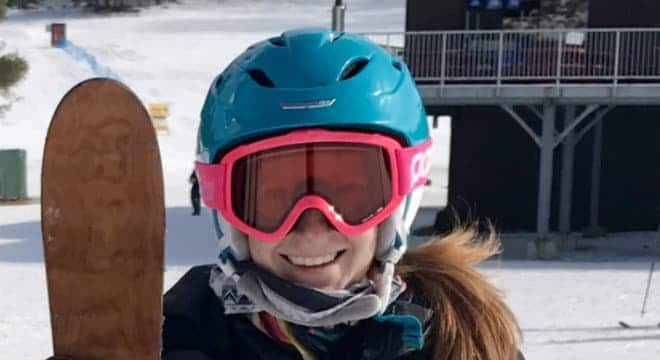
Jules Gansl is a young working professional, living in New York City. When she was only 3, Jules took her first run on the bunny hill at Otis Ridge in Western Massachusetts. From that moment on, she was hooked, and her parents enrolled her in ski school at another family mountain nearby, Ski Butternut, to which they returned every winter weekend. At age 14, Jules became an instructor at Butternut’s ski school, and spent the next eight years teaching children to ski alongside many of the same instructors who had taught her as a small child. After graduate school, Jules connected with friends who had recently founded the Ivy Ski Club, and joined their membership of enthusiastic skiers from around the world. Over the next several years, Jules spent countless weekends in the Adirondacks and took many week-long vacations to some of the best ski regions in the world. Jules’ love of skiing turned into her biggest passion and she is excited to be sharing some of her latest ski adventures with Ultimate-Ski










